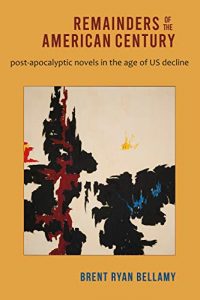Alvaro Zinos-Amaro Reviews Remainders of the American Century: Post-Apocalyptic Novels in the Age of U.S. Decline by Brent Ryan Bellamy
 Remainders of the American Century: Post-Apocalyptic Novels in the Age of U.S. Decline, Brent Ryan Bellamy (Wesleyan University Press 978-0819580313, $24.95, 256pp, pb) June 2021.
Remainders of the American Century: Post-Apocalyptic Novels in the Age of U.S. Decline, Brent Ryan Bellamy (Wesleyan University Press 978-0819580313, $24.95, 256pp, pb) June 2021.
In this fascinating study of primarily US post-apocalyptic fiction from the end of WWII through the 2007-8 financial crisis, Brent Ryan Bellamy engages with “the fields of American studies, science fiction studies, and print culture studies” to unpack how these narratives have changed over time, how they reflect the American political landscape, and how publishing forces have shaped their evolution. Bellamy’s theoretical apparatus is broad in scope – “a range of methodologies from critiques of nationalism to those of petroculture and a range of frameworks from critical race theory to feminist and queer studies critiques of reproductive futurity,” as he says – but his reasoning remains clear throughout, and he frequently orients the reader, reminding us where we are and what we’re about to tackle next. The book consists of a lengthy Introduction, seven chapters, and a Conclusion. “Post-apocalyptic novels are not about the end of the world,” Bellamy observes, but rather “express cultural anxiety about the end of US hegemony and the long, slow, and painful acclimatization to life under neoliberalism, especially for those who up to this point have enjoyed a relatively high standard of living.” In case that sounds too reductionist, fear not, because Bellamy enriches and develops this idea in subtle and provocative ways through a myriad of close textual readings, the details of which are often as much fun, if not more, than the conclusions we might draw from them. Though “a dominant trend can be found in the post-apocalyptic novels examined in this book: they treat crisis as opportunity and encourage an understanding of history that counterintuitively valorizes the individual over the collective and seeks a return to the way things were,” Bellamy allows for exceptions and border cases, which bolsters the integrity of his analysis. In the Introduction, Bellamy, following work by Veronica Hollinger, explains that rather than treating post-apocalyptic narratives as a genre or subgenre, his approach is to view them as a “mode,” and taking a cue from a piece by Umberto Eco about the difference between allegory and symbol, argues for the value of this mode being considered symbolically. “The post-apocalyptic text envisions how characters might respond to world-destroying events,” while “the post-apocalyptic mode imagines how a culture, nation, or people might respond to having their way of life suddenly transformed in the most dramatic of ways.”
An intriguing and innovative concept that Bellamy deploys to investigate this macro-textual post-apocalyptic mode is that of “remainders.” Briefly, for Bellamy this term operates on at least three levels, all of which receive his attention: “it identifies diegetic things (objects, people, and places), literary concepts (forms, plots, and styles), and real-world materials (remaindered books) as components and markers of a single process of abandonment, failure, and ruin.” Just as the futures depicted in post-apocalyptic visions are “littered with the remainders” of their pre-disaster worlds, so are “remainders” of story elements themselves not annihilated but rather broken up and recycled from text to text. Remaindering is the key linkage between the different dimensions of Bellamy’s investigation, and it’s hard to do its versatility of valences justice in a few short sentences.
The close readings I mentioned begin with George R. Stewart’s Earth Abides, Leigh Brackett’s The Long Tomorrow, Walter Miller Jr.’s A Canticle for Leibowitz, and Richard Matheson’s I Am Legend, which serve to underscore the basic point that the protagonist or narrator of post-apocalyptic stories tends to be privileged in complex ways. This opening chapter is useful to establish a groundwork of tropes, but the progression from book to book feels a bit staid. Things liven up with the elaboration of “world destroying” and “reduction,” after work by Gary K. Wolfe, as key strategies for deciphering how these stories are assembled, and then applying the aforementioned to Sherri S. Tepper’s The Gate to Women’s Country and Stephen King’s The Stand. Three later discussions consist of, first, an energetic comparison of David Brin’s The Postman with Kim Stanley Robinson’s The Wild Shore – the latter offers a wealth of “variant possibilities for social organization” not present in the former, pushing back against the notion of limited response to catastrophe – secondly, a contrasting of the opposed ways of critiquing whiteness in Robert A. Heinlein’s Farnham’s Freehold and LeVar Burton’s Aftermath – Bellamy points out that while Heinlein may have been aiming for a critique of racism, he instead “targets slavery…through a series of racist tropes” – and, thirdly, an examination of family and specifically the role of gender in Cormac McCarthy’s The Road. Other texts probed, in the context of energy limitations, include Octavia Butler’s Parable of the Sower, Emily St. John Mandel’s Station Eleven, Pat Frank’s Alas, Babylon, Peter Heller’s The Dog Stars, James Howard Kunstler’s World Made by Hand, and John Varley’s Slow Apocalypse. Works by Colson Whitehead and N.K. Jemisin also receive coverage on the book’s closing pages.
Bellamy’s insights into the above narratives are stimulating, but my favorite chapter is admittedly the one on “Remaindered Books.” The details of publishing industry trends and movements, tracing the cresting of midlist authors in the 1960s through the changes of the 1970s, the crisis sparked by “the landmark case Thor Power Tool Company v. Commissioner of Internal Revenue” in the 1980s, which led to the remaindering of books, the explosion of best-seller-dom in the ’90s, and the proliferation of self-publishing, specialty presses and genre/literary dalliances in the 2000s and beyond, all make for a fascinating chronicle in their own right. When reading about the hundreds of formula-based books in the Deathlands and related series, for instance – or learning that “at the time of this writing, Permuted Press has published over 500 titles, with 290 in the apocalyptic, post-apocalyptic, and survival or horror-fiction categories” – it’s hard to argue against the mostly conservative tastes of post-apocalyptic fiction readers. The post-apocalyptic mode includes, undeniably, a cottage industry whose success not only relies on but, as Bellamy so eloquently phrases it, “guarantees the failure of every apocalypse.”
In the context of his project, Bellamy’s deliberate restriction to American works makes sense, but it might have still been interesting to explore more of the interplay between U.S. post-apocalyptic narratives and those hatched elsewhere, specially given the rich post-apocalyptic tradition in the U.K. and the “parallel between the sorts of speculative fiction created in fin de siècle Britain and those created in the present-day United States” that Bellamy alludes to. The end-notes are definitely worth checking out, and all the key reference works one might wish for are duly cited. Two additional titles of potential interest to readers who enjoy Bellamy’s treatise are Post-Apocalyptic Patriarchy: American Television and Gendered Visions of Survival by Carlen Lavigne and The Ongoing End: On the Limits of Apocalyptic Narrative, edited by Michael Titlestad and David Watson.
It’s clear from Bellamy’s thoughtful, animated, and well-written work that while the post-apocalyptic mode embodies disruption in its storyworlds, if mostly only to immediately reduce or annul the effects of such disturbances, the mode itself seems particularly resilient to real-world disruptions. “According to a bibliography of titles I produced, the number of US post-apocalyptic titles more than doubled between 2001 and 2014,” Bellamy notes, and I hesitate to ask for the post-pandemic math. The post-apocalypse remains, and remainders on.
This review and more like it in the August 2021 issue of Locus.
 While you are here, please take a moment to support Locus with a one-time or recurring donation. We rely on reader donations to keep the magazine and site going, and would like to keep the site paywall free, but WE NEED YOUR FINANCIAL SUPPORT to continue quality coverage of the science fiction and fantasy field.
While you are here, please take a moment to support Locus with a one-time or recurring donation. We rely on reader donations to keep the magazine and site going, and would like to keep the site paywall free, but WE NEED YOUR FINANCIAL SUPPORT to continue quality coverage of the science fiction and fantasy field.
©Locus Magazine. Copyrighted material may not be republished without permission of LSFF.






